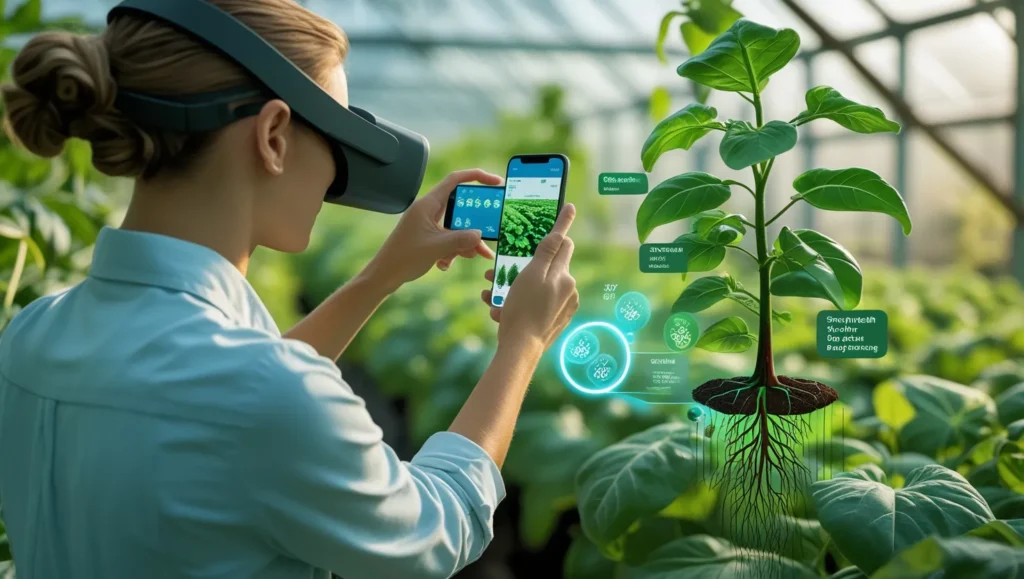
Imagine pointing your smartphone at an undeveloped patch of soil and then instantly observing how different plants appear. Imagine walking through a forest and receiving real-time information on every plant you encounter. It’s not science fiction; it’s the potential of Plant Augmented Reality.
In an era where digital tools are transforming the way we interact and learn, Plant AR brings nature to life as never before. It helps people learn about how plants work, make better choices in their gardening, and contribute to the protection of threatened species.
We’ll examine the basics of what Plant Augmented Reality means, its functions, usage, and how its benefits extend beyond convenience. Let’s get started.
What is Plant Augmented Reality?
Plant Augmented Reality is the application of AR technology to mix real-world plants (or areas where they could develop) by overlaying digital images. These overlays can include:
- 3D plant models
- Interactive labels
- How to care instructions
- Simulations of growth
The entire process occurs in real-time and is viewed through a smartphone, tablet, or AR glasses.
The purpose is to help people see, learn, understand, and interact with plants in more profound ways. For example, a student studying plant anatomy, a gardener designing a layout, or a conservationist trying to identify rare species can benefit from Plant AR, which provides an interactive experience that is visually appealing and more engaging.
5 Biggest Benefits of Plant Augmented Reality
Let’s find out why Plant Augmented Reality is more than just a cool feature. It’s a highly effective tool for sustainability, education, and connecting.
1. Learning About Plants Easier and More Fun
Botany is a complex field. From photosynthesis to the anatomy of plants, numerous concepts are challenging to comprehend just through studying. Plant AR can solve this problem through:
- Making lessons interactive and tactile experiences
- Students can understand how plants work
- It makes it easier for people to recall what one has learned
In Reality, research indicates that students who study using AR are more active and have higher scores in science-related subjects.
2. Plan Smarter, Greener Spaces
Have you ever bought an attractive plant at the shop, only to find that it didn’t work in your space or last for long?
You can:
- A preview of what a plant will appear and develop over time
- Find out which plants work best for the size, light level, and climate
- Mix species to create an attractively balanced garden
It can help both novice gardeners and landscape designers make informed, educated decisions.
3. Environmental Education and Awareness

One of the most significant obstacles to environmental conservation is a lack of awareness. Most people are unaware of the plants that are endangered, invasive, or vital to the ecosystem in which they live.
The modification of Plant Augmented Reality
- Giving instant information when you look at the plant
- It highlights native as well as invading species
- Shows how ecosystems can be interconnected
It’s an instrument that could inspire the environment, particularly in younger generations.
4. Safe, Risk-Free Experimentation
Researchers and students can play using a variety of plant types or environmental conditions, without harming actual plants. For instance:
- Students can test what happens when plants don’t receive enough sunlight
- A researcher can simulate the effects of drought
- Designers can visualize how trees will develop over 10 years.
5. Nature Accessible to Everyone
Many people lack access to natural spaces, botanical gardens, or outdoor learning environments. With Plant AR:
- The city dwellers can experience the virtual garden at their homes
- Mobility-impaired people can research nature using their devices
- Anyone, from anywhere, can interact with plants in significant ways
This method, AR, helps bridge the gap between technology and nature, thereby making plant knowledge truly universal.
Real-World Uses of Plant Augmented Reality
It’s already being utilized in many ways
1. Education
Students and teachers can study the plant life sciences in a hands-on manner. Instead of reciting textbook diagrams, students can:
- Engage with 3-D models of the roots, stems, and branches
- Watch animated videos of how plants develop and reproduce.
- Locate the plants that are native to the school grounds with an image.
It makes learning more interesting, visual, and memorable.
2. Gardening and Landscaping
Professionals and homeowners are utilizing AR to design gardens more effectively. Plant AR can:
- Test different types of plants before you plant anything
- Test the combinations of plants, flowers, or trees
- Placement adjustment based on the amount of sunlight and the height of growth
3. Environmental Conservation
Plant AR assists conservationists:
- Monitor the spread of
- Many human activities endanger plant species in the wild
- Inform communities about the local ecosystems
Through making plant information easier to access, AR is supporting real environmental actions.
4. Smart Farming
Certain farmers utilize HTML0 AR using drones and smartphones to
- Monitor crop health
- Predicting water and fertilizer requirements
- Stop early outbreaks of disease
It is part of an expanding field known as precision agriculture, which utilizes information to produce food more efficiently and effectively.
What’s Next for Plant Augmented Reality?
What’s to come from Plant Augmented Reality is even more thrilling. What can we expect from Plant AR:
- Integration with AI AR tools will be more intelligent, providing personalized recommendations for plant care.
- Wearable AR glasses: Similar to glasses that recognize plants as you stroll through a forest.
- Communities for virtual gardening: Where members can share their ideas, seek guidance, and work together on green public projects.
As technology advances, Plant AR is likely to become more prominent in conservation, education, agriculture, and everyday life
Conclusion
In an increasingly digital world, Plant Augmented Reality offers a unique way to reconnect the human experience with nature, providing rich and meaningful experiences. If you’re studying plant biology, designing a garden, or protecting endangered species, AR can’t substitute for the real plant; it improves our interaction with them.
By blending accurate data with a visual narrative, Plant AR helps us see that plants are not only a backdrop but also living systems that we can learn from, take care of, and safeguard. From cities to classrooms and greenhouses to gardens, this technology is helping lay the foundations for a more educated and sustainable future.
As Plant AR develops, one thing is sure: it’s not just about technology, but about enhancing our connection to our natural environment.
FAQs
What exactly is Plant Augmented Reality, and how can it be used?
Plant Augmented Reality is a tech that overlays digital information, like 3D images of plants, care tips, or identification information–over onto the real world with your tablet, smartphone, or even AR glasses. It utilizes the camera on your Device and sensors to study the surrounding environment and “augment” it with plant-related content in real-time
Is Plant Augmented Reality helpful for environmental conservation?
Yes, Plant Augmented Reality is a new instrument for ecological conservation. Here’s how:
- Instant identification of species out in nature (e.g., for spotting the presence of invasive species)
- Informing communities using AR-enhanced field guides
- Simulation of the restoration of projects and simulations of plant growth
- Engaging the public through captivating stories of indigenous plants, ecosystems, and species.
What challenges are associated with Plant Augmented Reality?
Even with its advantages, however, there are some issues:
- The accuracy of plant identification depends on the lighting conditions, the quality of the images, and the quality of the AI learning datasets.
- Limitations of the Device: Some AR features require specific devices, such as tablets or phones.
- Privacy issues: Applications may utilize geolocation data and camera information. Privacy policies need to be clear.
- Information gaps. There are gaps in the data on plants that are not listed in databases, particularly for rare or newly discovered species.
However, as AR technology develops and becomes more affordable, many of these issues will likely be resolved.
Can I use Plant Augmented Reality for indoor plant care?
Absolutely. A variety of Plant AR tools are ideal for indoor gardening. They can help you:
- Find out how different houseplants make the same space
- Know the amount of lighting and space plants require
- You will be reminded of when to water and prune.
- Find issues such as yellowing leaves or pests with visual scans
This is especially helpful for renters, urban dwellers, or anyone who wants to start an indoor plant collection.


